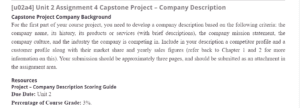Capstone Project Company Background
Company Description
Zara is a fashion subsidiary under the Spanish company Inditex. Zara is the flagship company of the Inditex Group, which manages other brands such as Bershka, Pull & Bear, and Massimo Dutti, and it is one of the global brands that keep up with fast fashion. The company releases new designs every few weeks to meet the high demand for fast-changing styles. Zara is also one of the most successful fashion brands, with more than 10,000 stores in several countries across all continents.
Do you need an original “Capstone Project Company Background essay” copy? Contact us.
Products and Services
The main product offered by Zara is fashion and clothing. The company provides various fashion items for men, women, and children. The company’s clothing is sold in over 10,000 stores worldwide and offers online sales. For online sales, customers from most parts of the world, including regions that do not have Zara stores, can gain access to the company’s products.
Revenue, Market Share, and Competitors
Zara is a billion-dollar company with a revenue of around $18 Billion. In recent years, the company has experienced growth in its income; in 2018, it experienced a 58% growth in its gross profit (Neumann, 2018). In every market that Zara exists, it faces competition from several companies. Therefore, the company’s market share is different in various markets. In the United States market, the main competitors of Zara include H&M, Forever 21, Mango, Urban Outfitters, and ASOS. Each competitor offers a similar range of products and services as Zara. The global brands offer relatively affordable fast fashion options for men, women, and children. The price ranges of these brands are similar to those of Zara, and they also focus on quality products at affordable costs like Zara. Therefore, the level of industry rivalry in fast fashion is significantly high.
Despite the competition, Zara has managed to maintain a relatively high market share. Given the nature of the fast fashion industry, it is difficult to determine the exact market share of a company. Customers in this industry are usually not loyal to just one brand; they shop across the companies in the sector (Bhardwaj & Fairhurst, 2010). Therefore, Zara and its competitors could share the same customers. Nonetheless, in terms of revenue, Zara is the best-performing brand among the ones mentioned. It has the highest market penetration, thus, enabling the company to make more sales than its competitors.
Industry-Wide Operational Needs
One of Zara’s most significant operational needs is the high demand for weekly production. The fast fashion market is very competitive. Every week, new companies develop new designs that gain popularity quickly in the market. The new designs lose popularity as fast as they earn, and the consumers demand more methods. Therefore, for Zara to remain competitive, it must continually develop new fashion designs quickly and produce many new inventories to be distributed to various markets.
Another operational need for this company is the high demand for consistency in product quality. With over 10,000 stores, this company produces millions of products every other week. In each global store, the customers expect consistency in the quality of the clothing. As a result, the company needs a very compelling quality control strategy to ensure that no defective products make it to the market.
This company is also in need of a very effective supply chain. When fashion products become popular, they are demanded by many people simultaneously. This company needs an effective supply chain to ensure its products get to customers on time. Zara needs to ensure that there is an adequate amount of inventory in over 10,000 stores and its online shopping warehouses. A good supply chain is required to distribute the necessary stock for every issue. With such a system, the company can ensure that all customers have the same level of satisfaction regardless of the market within which they are located.
Conclusion
Zara is a global fast fashion brand that faces competition from similar companies. This business is currently performing relatively well and achieving revenue growth. This performance is partly a result of the practical operations management by the company.
Other Related Post: Homeland Security
References
Bhardwaj, V., & Fairhurst, A. (2010). Fast fashion: response to changes in the fashion industry. The international review of Retail, distribution and consumer research, 20(1), 165-173.
Neumann, J. (2018). Zara’s parent Inditex’s Sales buck industry trend. Retrieved from: https://www.marketwatch.com/story/zara-parent-inditexs-sales-buck-industry-trend-2018-06-13
ORDER A PLAGIARISM-FREE PAPER HERE
We’ll write everything from scratch
Question
[u02a4] Unit 2 Assignment 4 Capstone Project – Company Description
Capstone Project Company Background
For the first part of your course project, you need to develop a company description based on the following criteria: the company name, its history, its products or services (with brief descriptions), the company mission statement, the company culture, and the industry the company is competing in.

Capstone Project Company Background
Please include in your description a competitor profile and a customer profile along with their market share and yearly sales figures (refer to Chapters 1 and 2 for more information on this). Your submission should be approximately three pages and should be submitted as an attachment in the assignment area.
Resources
Project – Company Description Scoring Guide
Due Date: Unit 2
Percentage of Course Grade: 3%.
| CRITERIA | DISTINGUISHED |
| Describe a company, its products or services, and its culture. 33% |
Describes a company, its products or services, and its culture associated with addressing industry-wide operational needs or issues. |
| Describe a company’s revenue, market share, and competitors. 33% |
Describes a company’s revenue, market share, competitors, and special needs and expectations of its customer base, such as value, quality, service, customer input, image, and partnering. |
| Describe a company’s industry-wide operational needs or issues based on its competition. 34% |
Describes a company’s industry-wide operational needs or issues based on its competition, with relevant details affecting the organization’s strategies and operations. |


